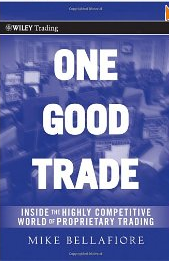Hi Mike, 
I just wanted to take the time to say thank you. A friend of mine recommended your book ‘One Good Trade’ (so much so he had ordered it for me insisting I read it) and it has not only helped my trading in so many ways, but has also been very inspirational!
If you don’t mind, a little background about myself. I’m 22 and from the UK, having graduated from university with a degree in Architecture and after having pursued that career path for a little while, I decided it wasn’t quite right for me, I’d always had an interest in the financial markets and figured I still had the time and resources to give it my best. I got into trading forex and with a stroke of luck and act of kindness had a great opportunity to sit with a very good trader at his desk on several occasions at the London prop firm he worked for.
I learned a lot about all aspects of trading then, and also with the help of this trader started becoming consistent in a longer term levels based strategy. Lots of screen time followed, and I had some good runs and some bad runs, my biggest fear had always been however, becoming complacent – especially since the nature of the strategy was longer term (at most getting a trade a day to on average two trades a week).
A great saying “Keep doing what you’ve been doing, and you’ll keep getting what you’ve been getting” comes to mind here, and I was slipping into complacency.
Anyway, since reading ‘One Good Trade’, I can’t express how much of a difference it has made. The strategy I had already been using was pretty similar to the set ups you explain in the book, so my next step was to bring it down a time frame and apply the same set ups to trading intra day on tick charts (rather than hourly/daily). I learned that I had to adapt, especially in the way the markets have been so far this year with the low volatility. I had become complacent and blamed the low volatility for the lack of trades, when really upon further investigation there were plenty of opportunities when done right.
For example, instead of complaining that the average daily range isn’t even half of what it was this time last year, I found this provides excellent fade opportunity at those range levels.
Also, although I reviewed all my trades and kept a very detailed journal, because those trades were few and far between the potential learning experience was cut. Compared to the changes I’ve made since reading your book, the learning curve has now increased drastically. For instance, every day ends with going over the same market again but producing a ‘best case scenario’ play and comparing that to the trade I took. I also look for further clues to where I could have cut trades quicker or added more size when needed.
Anyway, this got a bit longer than I had intended (hope you don’t mind) – I just wanted to say thank you again, for taking the time to pass on your own experiences and that of others in your book. I feel it’s definitely pushed me back onto the right track and the book itself was very informative as well as just fun to read! Another thing I got from it is persistence is key, I love what I do and I have no doubt I’ll get there in the end.
@MikeBellafiore
There are two learning opportunities in this post above:
1) play around with different time frames for your setups
2) frustration can lead to break through
There can be better time frames to express your ideas. Some on our desk expand their time frames to 15m charts to find better success from 1m and TICK charts. I had a chat with a trader the other day who did the reverse. He went from consistently negative to flat this month by decreasing his time frame from 15m charts and wider stops.
Even time of day can make a significant difference in results. I am presently backtesting an idea that shows very different results by entry time for the same strategy.
Frustration that fuels progress is very healthy. This trader has done that here. Recently I got ripped being cute and trying to trade out of a GPRO short overnight. I turned a small loss into a large one. A NASDAQ buy imbalance at 9:28 was the catalyst from small to large loss.
One could carp about the bad luck of this imbalance. But you can also use this frustration to propel innovation. I later had a discussion with a talented trader who loves exploiting trade inefficiencies. I shared the move in GPRO after this imbalance and asked if we could find edge with these imbalances going forward. Maybe a new edge will result.
Related Posts:
Lessons from a New Trader Succeeding
What Comes Next for the Profitable Trader
From Here You Can Become a Really Good Trader
“You can be better tomorrow than you are today!”
Mike Bellafiore is the Co-Founder of SMB Capital and SMBU, which provides trading education in stocks, options, forex and futures. Bella is the author of One Good Trade and The PlayBook.
No relevant positions
